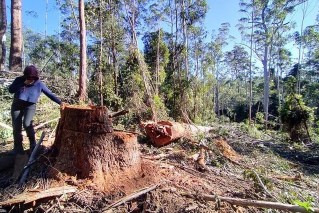Rapidly rising floodwaters spark Melbourne evacuations, but rain eases

Evacuations were ordered in suburban Melbourne on Friday morning as Victorians remain on high alert for dangerous flooding, despite the rain expected to ease shortly for much of the state.
Forecasters told residents to heed warnings as water flows downstream and rivers peaked, with warnings still in place for multiple Victorian rivers.
Emergency responders had received more than 3000 calls for assistance.
The severe weather warning for Victoria was cancelled on Friday morning.
However in the early hours, evacuation orders were issued due to rapidly rising floodwaters in Melbourne’s Maribyrnong River at suburban Maribyrnong and Keilor, and in Benalla, north-east of the city.
Other areas were urgently told to move to higher ground including Goulburn River (Lake Eildon to Seymour), Broken River downstream of Casey Weir and Mt Emu Creek to Skipton.
Tweet from @jasonmills_x
An evacuation order was issued for Wedderburn early on Friday, amid indications the Skinners Flat Reservoir was set to breach.
“This will result in approximately 3 feet (90 centimetres) of strong fast moving waters from the Skinners Flat Reservoir through the Wedderburn Township via the Calder Highway and out towards Wedderburn Junction Road,” Victorian emergency authorities said.
Residents in Benalla were also told to leave their homes immediately because of rapidly rising floodwaters.
Tweet from @FerrierSteph
Authorities issued several emergency warnings on Thursday, advising people to immediately evacuate, including for Rochester along the Campaspe River, Carisbrook near Maryborough, and Seymour along the Goulburn River.
People in Rochester were told to abandon their homes as floodwaters rapidly rose. Flooding was expected to inundate the area from early Friday, with the river peaking in the afternoon.
Emergency relief centres were set up close to Rochester, Carisbrook and Seymour.
Those along the Campaspe River from Lake Eppalock to Barnadown were told to move to higher ground.
An emergency warning was also issued for Seven Creeks to Euroa.
Watch and act alerts urging people to stay indoors were widespread across Victoria.
Areas north of the Great Dividing Range were among the heaviest hit by the rain on Wednesday and Thursday, and more central areas also had significant falls, according to the Bureau of Meteorology.
The Severe Weather Warning for #Victoria has been cancelled. The rainfall rates have eased about NE Victoria, but there will still be a few more hours before the cold front clears to the east of the State. pic.twitter.com/zsJlJnN9RG
— Bureau of Meteorology, Victoria (@BOM_Vic) October 13, 2022
Rainfall from 9am Thursday to Friday morning was highest in the Goulburn, Broken basin:
- Strathbogie North 93 millimetres
- Moroko Park 90 millimetres
- Pyalong 79 millimetres
- Avalon Station 75 millimetres
- Kinglake 76 millimetres
- Strathbogie 72 millimetres
- Balquhain 72 millimetres
- Polly McQuinn Weir 72 millimetres
Other high totals were at Upper Buckand (80 millimetres) and Archerton (83 millimetres).

Ascot, a northern suburb of Bendigo, goes under on Thursday. Photo: AAP
The weather started to clear in western Victoria on Thursday night, and forecasters predicted it would improve for the state’s central areas and then into the east on Friday.
“Other than that, rainfall over Gippsland and the eastern ranges [on Friday], the rest of the state’s really not going to see much … so, less than 5 millimetres for most places,” the bureau’s Bri Macpherson said on Thursday night.
“Then over the weekend, it’s just really isolated showers most likely in the south of the state.”
While the rain would ease, there was still plenty of water that had to make its way through river systems and flow downstream.
“The peaks might not go through until [Friday] or Saturday for some of the river catchments, so even after the rain has stopped it’s important to keep an eye on the flood warnings.”

The water inching up at Strathfieldsaye, Bendigo. Photo: AAP
Earlier on Thursday, Victorian SES chief operations officer Tim Wiebusch said Seymour faced its highest flood level since 1974.
There was potential for 187 properties to be inundated by floodwaters and a further 279 to be isolated, he said.
Authorities expected up to 700 properties in Rochester to be isolated by Friday, and Shepparton to experience its worst flood in almost three decades on Saturday afternoon, with up to 600 properties isolated.
The bureau warned of damaging wind gusts over elevated areas in the state’s central and eastern parts, but they were expected to clear eastwards on Thursday evening.
Tasmania floods

The Mersey River from Railton Road bridge at Kimberley, Tasmania on Thursday. Photo: AAP
Flood-hit communities in north and north-west Tasmania are entering a “danger period” as rivers rise, with evacuation orders for multiple towns and part of Launceston.
Evacuations orders were issued on Thursday night for communities along sections of the swollen Mersey and Meander rivers in the state’s north-west.
⚠️ #Flood Warning for the River Derwent has been upgraded with Major flooding expected along the River Ouse during Friday.
See https://t.co/NHL3HYiaxm for details and updates;
follow advice from @SESTasmania #TasFloods pic.twitter.com/7nseMMyBQL— Bureau of Meteorology, Tasmania (@BOM_Tas) October 13, 2022
Heavy rain that began on Wednesday night started to ease on Friday morning with falls across the region in excess of 400 millimetres.
Evacuation orders are in place for 20 towns along the swollen Mersey River and Meander River, downstream of Lake Isandula dam and in the Launceston suburb of Newstead.
“This is actually the danger period. Our messaging to the Tasmanian public at this point in time is ‘don’t be complacent’,” State Emergency Services acting director Leon Smith told the ABC on Friday.
“All of that rain that’s fallen at the higher altitudes still needs to make its way down through the riverine systems. This flooding will be sustained.”
Mr Smith said it would take several days for waters to subside.
Emergency services rescued a family of six who became isolated on their property, while a man and woman were helped to safety by helicopter after driving through floodwaters in their 4WD.
The SES issued an emergency evacuation alert on Thursday night for 42 homes south of the dam at Lake Isandula after being advised it was at risk of failure.
By Friday morning, the dam’s water level was considered stable.
A full assessment would be undertaken on Friday.
About 70 homes in Newstead were also evacuated overnight, with the SES receiving 147 calls for assistance from flood-hit areas.
Authorities have warned river peaks in some parts could reach levels seen in mid-2016 when flooding claimed three lives and caused $180 million worth of damage.
The Great Lakes area in Tasmania’s central-north topped the rainfall tally with 220 millimetres in a 24-hour window on Thursday, while records were broken elsewhere.
Five people and their animals were rescued from a property at Liffey, southwest of Launceston, on Thursday.
Evacuation centres have been set up at several locations.
Tasmania Police has urged people to avoid travelling unnecessarily and to not drive through floodwaters.
NSW rainfall to ease as cold front leaves
NSW will get a reprieve by the weekend as a cold front heads away from the east coast but the limited rainfall will add strain to already swollen rivers.
The Bureau of Meteorology has warned people in southern inland NSW should remain alert for flash flooding.
On Thursday, the SES ordered hundreds of people to evacuate parts of Forbes in central western NSW by 8pm before major flooding hit.
The Lachlan River was expected to reach a major flood peak of 10.6 metres later on Thursday or early on Friday, prompting the emergency warnings.
Severe Weather Warning issued at 10:40pm 13/10/22 for parts of South West Slopes, Riverina, Snowy Mountains and Australian Capital Territory Forecast Districts.
For more information and to monitor conditions visit: https://t.co/FRxGiycuxW pic.twitter.com/KulBHAY1BE
— NSW SES (@NSWSES) October 13, 2022
Moderate flooding also affected Wagga Wagga after the Murrumbidgee River peaked on Thursday morning.
A deep low-pressure system is combining with a deep tropical air mass, and forecast to produce areas of heavy rainfall over southern parts of the lower western and Riverina districts, and onto the western slopes of the Alpine region overnight.
The system will also bring gusty alpine winds.
“Widespread rain, combined with wet or already flooded catchments, will lead to renewed river and creek rises,” the bureau said.
Flood warnings are current for catchments across southern NSW.
Locations that may be affected include Albury, Tumbarumba, Deniliquin, Hay, Broken Hill, Wentworth and Balranald.
Although clear skies are on the horizon, the fortnight ahead will be soggy with above-median rainfall (greater than 80 per cent chance) on the cards for large parts of the eastern two-thirds of Australia.
-with AAP








